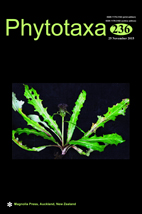Abstract
Three new species of Cypella are described and illustrated for the complex of grasslands ecosystems of Rio de La Plata: C. aurinegra, C. guttata and C. ravenniana. The former is endemic to the region of the Taquari river, southern Cerro Largo Department, Uruguay, and is closely related to Cypella fucata and C. luteogibbosa, but can be distinguished from these species by its yellow flowers stained with dark-purple, narrower outer tepals, smaller inner tepals, shorter adaxial crests of style branches, slender filaments, and seeds with smooth testa. Cypella guttata occurs in Artigas and Rivera Departments, northern Uruguay, and in Santana do Livramento Municipality, southwestern Rio Grande do Sul State, Brazil. This species resembles C. herbertii and C. lapidosa, and can be distinguished by its flowers with central depression showing red spots, filaments narrower and tape-shaped, style branches with shorter adaxial crests, and small transverse stigmatic surface of the abaxial crest. The range of geographic distribution of C. ravenniana includes southern Misiones, and northeast Corrientes Provinces, Argentina, and west and northwest Rio Grande do Sul State, Brazil. This species can be recognized by its one-flowered spathes, borne on short peduncles. Cypella ravenniana was firstly misidentified as C. suffusa; however, having as base the type and topotypical collections of the latter species, C. suffusa is recognized by its two-flowered spathes borne on long peduncles, and perigone golden-yellow with deep central concavity. Data about phenology, geographic distribution, conservation and dichotomous keys to segregate these three new species from its related species are supplied.

